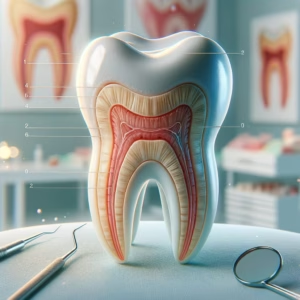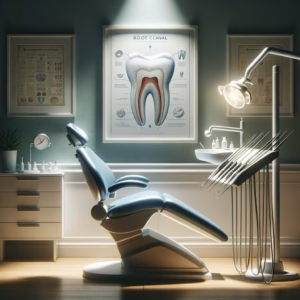Understanding Root Canals
Understanding Root Canals: A Comprehensive Guide
Root canals are a vital dental procedure that often stirs anxiety and confusion among patients. However, understanding the concept, the anatomy of a tooth, and the reasons adults may require a root canal can demystify the process and highlight its importance in maintaining dental health.
The Anatomy of a Tooth
To appreciate the significance of root canals, it’s essential to understand tooth anatomy. A typical tooth consists of three main layers:
Enamel: This is the hard, outer layer that protects the tooth. It is the hardest substance in the human body and plays a crucial role in safeguarding the underlying structures from decay and injury.
Dentin: Beneath the enamel lies the dentin, a porous layer that is less dense than enamel. Dentin contains microscopic tubules, which can transmit sensations such as temperature and pressure.
Pulp: The innermost layer, the pulp, comprises nerves, blood vessels, and connective tissue. The pulp is essential for tooth development and health, providing nutrients and sensation to the tooth.
The Importance of Root Canals
A root canal is a procedure designed to treat infection or damage within the pulp of the tooth. When the pulp becomes inflamed or infected due to various reasons—such as deep decay, repeated dental procedures, or trauma—the tooth can become extremely painful and lead to further complications if left untreated. A root canal aims to remove the infected pulp, clean and disinfect the root canal system, and seal it to prevent future infections.
The importance of root canals cannot be overstated. They help save teeth that might otherwise need extraction, preserving the natural tooth structure and function. Moreover, maintaining your natural teeth contributes to better overall oral health, minimizes the need for more complex dental procedures, and enhances your smile.
Common Reasons for Root Canals
Several factors may necessitate a root canal. Here are some common reasons adults may require this procedure:
Severe Tooth Decay: When cavities penetrate deep into the tooth, they can reach the pulp, leading to infection.
Trauma or Injury: A blow to the mouth can fracture a tooth or damage the pulp even if the tooth appears intact.
Repeated Dental Procedures: Multiple treatments on the same tooth can irritate the pulp, causing inflammation and pain.
Cracked or Chipped Teeth: Cracks can allow bacteria to enter the pulp, resulting in infection.
Gum Disease: Advanced gum disease can lead to infections that affect the tooth’s roots and pulp.
Conclusion
While the idea of a root canal may seem daunting, it is a routine procedure that provides significant relief from pain and can save a tooth from extraction. If you experience symptoms such as prolonged sensitivity to heat or cold, tenderness in the gums, or swelling around a tooth, it’s essential to consult your dentist promptly. Early intervention can lead to better outcomes and the preservation of your dental health. Remember, understanding root canals is the first step toward demystifying dental care and maintaining a healthy, beautiful smile.
Signs You May Need a Root Canal
Signs You May Need a Root Canal
Recognizing the signs that you may need a root canal is crucial for preserving your dental health and alleviating discomfort. The symptoms indicating a potential need for this procedure can vary, but some common indicators include:
Persistent Toothache: A defining symptom of a pulp infection is a persistent toothache. This pain may range from mild to severe and can be localized to one tooth or radiate to the surrounding areas. It can significantly disrupt your daily activities, making it challenging to focus on work, enjoy meals, or engage in social interactions. If you experience continuous or worsening pain, it’s essential to consult your dentist in Ashburn, VA.
Sensitivity to Hot or Cold: If you find that your tooth is particularly sensitive to hot or cold temperatures, it may be a sign of underlying issues within the pulp. This sensitivity can manifest as discomfort that lingers even after the hot or cold stimulus is removed. Over time, the sensitivity may evolve into a more intense pain or discomfort, indicating that a root canal may be necessary.
Swelling and Tenderness: Swelling in the gums surrounding a tooth can indicate that infection has spread, leading to inflammation. This swelling is often accompanied by tenderness, making it uncomfortable to touch or chew in that area. If you notice any swelling or tenderness in your gums, seek dental advice promptly to prevent further complications.
Discoloration of the Tooth: A tooth that becomes darker or discolored may suggest that the pulp has died or is severely damaged. This change in color can be a visible sign that a root canal is required to address the underlying issue and restore the tooth’s health.
Pain When Chewing: Experiencing pain while chewing or applying pressure to a specific tooth can indicate that the pulp is inflamed or infected. If you notice that certain movements or chewing actions elicit sharp pain, it’s a sign that you should contact your dentist as soon as possible.
Recurring Pimple on the Gums: Sometimes, an infection can lead to the formation of an abscess or pimple on the gums near the affected tooth. This pimple may drain pus, signaling an ongoing infection that requires immediate attention. Ignoring this symptom can lead to more severe complications, including tooth loss.
These symptoms not only indicate the possible need for a root canal but can also have a substantial impact on your quality of life. Difficulty in eating, constant pain, and social discomfort can affect your overall well-being.
If you are experiencing any of these signs, it is essential to consult your dentist in Ashburn, VA, as soon as possible. Early diagnosis and treatment can mitigate further complications, save your tooth, and help you maintain optimal dental health. Remember, proactive dental care is key to preventing more extensive procedures in the future.
The Root Canal Procedure Explained
The Root Canal Procedure Explained
Once diagnosed with the need for a root canal, patients can expect a systematic approach to the procedure that prioritizes comfort and effectiveness. Understanding each step of the root canal treatment can alleviate anxiety and prepare individuals for their visit to an endodontist in Ashburn, VA.
Step 1: Diagnosis
The root canal process begins with a thorough examination by your dentist or endodontist. They will conduct a clinical assessment of the problematic tooth and may take X-rays to visualize the tooth’s internal structures and check for infection at the root tip. This imaging helps in identifying the extent of decay or damage and guides the treatment plan.
Step 2: Anesthesia
Before the procedure begins, anesthesia is administered to ensure that the patient is comfortable and pain-free. Local anesthesia is most commonly used, numbing the tooth and surrounding area while allowing the patient to remain awake and aware during the procedure. In some cases, oral sedation or nitrous oxide (laughing gas) may be offered for patients who experience significant anxiety. It is essential to communicate any concerns about pain or anxiety levels with the dental team ahead of time to ensure adequate measures are in place for a comfortable experience.
Step 3: Preparation
Once the area is numb, the endodontist will isolate the tooth with a rubber dam. This keeps the tooth dry and free of saliva, which is crucial for maintaining a sterile environment during the procedure. The rubber dam also helps the dentist focus solely on the tooth that requires treatment.
Step 4: Accessing the Pulp Chamber
The next step involves creating an opening in the crown of the tooth to access the pulp chamber. Using specialized dental instruments, the endodontist carefully removes any decay and cleans the interior of the tooth. This access is vital for the subsequent steps, which involve thorough cleaning and shaping of the root canals.
Step 5: Cleaning and Shaping the Canals
With access achieved, the endodontist will use a series of small instruments called files to clean the interior of the root canals. This process effectively removes the infected pulp tissue, debris, and bacteria. The canals are thoroughly irrigated with an antimicrobial solution to disinfect the area, ensuring that no remaining bacteria can cause future infections.
The endodontist will also shape the canals to facilitate the filling material that will be placed later. This shaping usually involves widening the canals to create a more uniform and consistent shape, which aids in a successful sealing.
Step 6: Filling the Canals
Once the canals are cleaned and shaped, the next step is to fill them with a biocompatible material called gutta-percha. This rubber-like substance seals the space left by the removed pulp, preventing any reinfection. After the canals are filled, the access opening is sealed with a temporary or permanent filling, depending on the treatment plan discussed with the patient.
Step 7: Post-Procedure Care and Restoration
After the root canal procedure, the patient may experience some discomfort, which is generally manageable with over-the-counter pain relievers. The endodontist will provide specific aftercare instructions, which may include recommendations for medications, dietary restrictions, and oral hygiene practices to ensure proper healing.
In many cases, a follow-up visit is necessary to restore the tooth fully. Patients will often need to have a crown placed on the tooth to provide strength and protection following a root canal. The timely placement of a crown is essential, as it helps preserve the integrity of the tooth and prevents fractures.
Step 8: Aftercare
Good aftercare is essential for a smooth recovery. Patients in Ashburn, VA, are advised to monitor for any signs of infection, such as increased swelling or persistent pain beyond a few days. Regular follow-up appointments with the dentist are crucial to ensure the tooth is healing correctly and to address any potential issues.
The endodontist will also provide guidance on how to best care for the treated tooth. Maintaining good oral hygiene practices, including regular brushing, flossing, and dental check-ups, will help ensure the long-term success of the root canal treatment.
In summary, while the root canal procedure may seem complex, it follows a straightforward series of steps designed to alleviate pain and save the tooth. Understanding each phase—from diagnosis to aftercare—empowers patients to approach their treatment with confidence and clarity.
Recovery and Aftercare
Recovery and Aftercare: Navigating the Process Post-Root Canal
After undergoing a root canal, it’s crucial to follow a comprehensive recovery plan to ensure proper healing and comfort. While most patients can return to their normal activities shortly after the procedure, understanding the recovery process and adhering to aftercare recommendations can significantly impact your healing experience.
Immediate Post-Procedure Care
In the hours following your root canal, you may experience some discomfort and swelling. This is a normal response as your body begins to heal. To manage any pain, consider the following tips:
Pain Management: Over-the-counter pain relievers such as ibuprofen or acetaminophen can be effective in managing mild to moderate discomfort. Follow the dosage instructions on the packaging, and consult your dentist if you have any concerns about medication interactions or if you need a prescription for stronger pain relief.
Cold Compress: Applying a cold compress to the outside of your cheek near the treated area can help reduce swelling and numb the pain. Use the compress for 15–20 minutes at a time, ensuring to take breaks to prevent skin irritation.
Rest: Allow your body to recover by getting plenty of rest in the initial days after the procedure. Avoid strenuous activities that may exacerbate discomfort.
Dietary Recommendations
During the first few days after your root canal, consider modifying your diet to promote healing:
Soft Foods: Stick to soft, easy-to-chew foods such as yogurt, mashed potatoes, soups, and smoothies. Avoid hard, crunchy, or sticky foods that can put pressure on the treated tooth.
Room Temperature Foods: Hot or cold foods can trigger sensitivity in the affected area. Opt for foods that are at room temperature to minimize discomfort.
Hydration: Stay hydrated by drinking plenty of water. However, avoid using straws in the first few days, as the suction can disturb the healing process.
Follow-Up Visits
After your root canal, it is essential to attend all scheduled follow-up appointments with your dentist in Ashburn, VA. These visits allow your dentist to monitor your healing progress, ensure that the infection has resolved, and check for any potential complications. Typically, a follow-up occurs within a week or two after the procedure, but your dentist will provide specific recommendations based on your individual needs.
Monitoring Healing Progress
As you recover, keep an eye on your symptoms. While some discomfort is expected, you should reach out to your dentist if you experience any of the following:
- Worsening pain or swelling that doesn’t improve with time or medication.
- Fever or chills, which may indicate an infection.
- Changes in the bite or difficulty chewing.
- Any unusual symptoms that concern you.
Communicating openly with your dentist about your recovery can help address any issues promptly and ensure a smooth healing process.
By following these recovery and aftercare guidelines, patients can support their healing journey and enjoy the benefits of their root canal procedure. Remember that prioritizing your oral health contributes to your overall well-being, so make sure to adhere to your dentist’s recommendations and maintain regular dental check-ups.
Addressing Common Myths
Addressing Common Myths About Root Canals
Despite the crucial role root canals play in dental health, many misconceptions persist, often fueling anxiety among patients in Ashburn, VA, and beyond. Let’s explore and dispel some of these common myths to foster a better understanding of this vital procedure.
Myth 1: Root Canals Are Extremely Painful
One of the most prevalent myths is that root canals are unbearably painful. In reality, most patients report that the procedure itself is no more uncomfortable than having a routine filling. Modern dentistry has made significant advancements in pain management. Dentists typically use local anesthetics to numb the area completely before beginning the procedure. According to Dr. John Smith, a dentist in Ashburn, “With proper anesthesia and techniques, patients often feel little to no pain during the root canal process.”
Furthermore, many patients express relief following the procedure. “I was so nervous about the pain,” shares Sarah, a local resident who recently underwent a root canal. “But honestly, I felt nothing during the treatment, and the pain I was experiencing before was gone afterward. It was a huge relief!”
Myth 2: Root Canals Are Unnecessary
Another common misconception is that root canals are unnecessary and that pulling the tooth is a better option. However, extracting a tooth can lead to further complications, including shifting of adjacent teeth, changes in bite, and even jawbone deterioration over time. Root canals, on the other hand, allow patients to keep their natural teeth, which is always the preferable option when possible.
Dr. Emily Johnson, an endodontist in Ashburn, emphasizes the importance of saving natural teeth, explaining, “Root canals have a high success rate and can significantly extend the life of a tooth. They help maintain the integrity of the dental arch and prevent future dental issues.”
Myth 3: Root Canals Take a Long Time to Heal
Many individuals believe that recovery from a root canal is a lengthy and complicated process. In truth, most patients return to their everyday activities shortly after the procedure. While some discomfort may occur in the days following the treatment, it is typically manageable with over-the-counter pain relievers, and most people find that their gums heal within a week or two.
“I was surprised at how quickly I could get back to normal after my root canal,” says Tom, another Ashburn resident. “I took a day off to rest, but by the next day, I was back at work without any issues.”
Myth 4: All Root Canals Are the Same
Patients often believe that root canals are a one-size-fits-all treatment. However, each case is unique, requiring tailored approaches based on the tooth’s condition and the extent of the infection. Dentists in Ashburn use advanced imaging technologies to diagnose and create personalized treatment plans for each patient, ensuring the best outcome.
Overall, dispelling these myths can help alleviate fear and anxiety surrounding root canals. As more patients in Ashburn, VA, share their positive experiences, the stigma surrounding this essential dental procedure continues to fade. Remember, if you experience symptoms indicating the need for a root canal, consulting with your dentist for timely intervention can make all the difference in your oral health journey.
The Importance of Preventative Care
The Importance of Preventative Care
Preventative dental care is key to avoiding the need for root canals and ensuring long-term oral health. Routine check-ups and proper oral hygiene practices are essential components of a proactive dental care strategy. Regular visits to your dentist in Ashburn, VA, allow for early detection of potential issues, such as cavities or gum disease, before they escalate into more serious conditions that may require invasive procedures like root canals.
Routine check-ups, typically recommended every six months, provide an opportunity for your dentist to conduct thorough examinations and professional cleanings. During these visits, your dentist can identify early signs of decay or infection, allowing for timely intervention. X-rays may also be taken to assess the health of your teeth and roots, providing a clear picture of your oral health status.
Proper oral hygiene practices at home play a crucial role in preventing dental issues. Brushing your teeth at least twice a day with fluoride toothpaste and flossing daily help remove plaque and food particles that can lead to decay and gum disease. It’s also important to use a soft-bristled toothbrush and replace it every three to four months to ensure effective cleaning. Rinsing with an antimicrobial mouthwash can further help reduce plaque buildup and maintain overall oral health.
The role of dentists in safeguarding oral health cannot be overstated. Dentists not only provide treatment but also educate patients on best practices for maintaining dental hygiene and preventing disease. They can offer personalized advice based on your specific oral health needs, including dietary recommendations to help protect against decay. Regular communication with your dental care team fosters a collaborative approach to your oral health, empowering you to make informed decisions.
In addition to routine care, lifestyle choices significantly impact your dental health. Avoiding tobacco products, limiting sugary snacks and beverages, and staying hydrated contribute to a healthier mouth. Furthermore, wearing protective gear during sports can shield your teeth from trauma, reducing the risk of injury that could lead to root canals.
Conclusion
In conclusion, adopting a comprehensive approach to preventative dental care not only enhances your smile but also safeguards your overall health. By prioritizing regular check-ups, practicing good oral hygiene, and collaborating with your dentist in Ashburn, VA, you can significantly reduce the risk of needing root canals and maintain a lifetime of healthy teeth.






